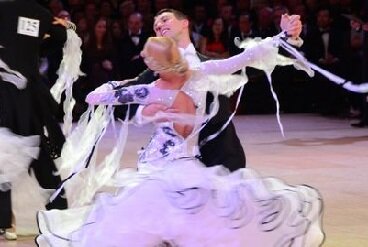The 3 Basic V Waltz Routines
8 June 2016
Viennese Waltz is just Natural and Reverse Turns, so there's no need to plan a routine, right? Wrong. Though it may not be as complex as your other routines, a Viennese Waltz routine can help you look better than just haphazardly throwing together Natural and Reverse Turns. There are a few different basic routines that people dance, which can be modified to fit your dancing. If you don't have a routine yet, now is the time to make the decision. This post will provide an overview of the three most popular basic Viennese Waltz routines, used by Amateurs and Professionals alike.
Routine 1: The Musical Routine
This routine tries to stay as musical as possible, because being musical makes your dancing look stronger and more interesting without any extra effort on your part.
| Natural Turn | 123, 223, 323, 423, 523, 623, 723 |
| Back Change | 823 |
| Reverse Turn, starting Back | 123, 223, 323, 423, 523, 623, 723 |
| Forward Change | 823 |
| Repeat |
An advantage to this routine, in addition to it being the most musical of all routines, is that it's easy for the Lady to follow, since she will always know when you are going to dance a Change Step. This routine could be modified slightly by adding an extra 8 bars of Natural or Reverse Turns before a Change Step. If you feel you are particularly strong in Natural Turns, for example, dance twice as many to show the judges.
Routine 2: The Easy Routine
One of the hardest things in Viennese Waltz is dancing Reverse Turns around a corner, and this routine does away with that problem. Dance Reverse Turns only down the long sides, and dance Natural Turns around each short side.
| Reverse Turn | 223, 323, 423... |
| Forward or Back Change | ... |
| Natural Turn | ... |
| Forward or Back Change | ... |
| Repeat |
Another benefit of this routine is that it can start anywhere in the room, meaning if it is crowded in all the corners, it can start along the side of the room, or vice versa. If you're along the side of the room, you can start with the Reverse Turn, as shown above, or you can start with the Natural Turns if you're near the short side. This means you will never start feeling crunched by other dancers around you.
The fact that the routine is written above starting with a Reverse Turn is arbitrary, but what isn't arbitrary is that the Reverse Turn is danced not on 123 but on 223. Even though this routine isn't phrased to the music entirely, your dancing will always be more musical if the first half of the Natural Turn is danced on an odd bar (1,3,5, or 7) and the back half is danced on an even one, and the Reverse Turns should be the opposite. Therefore, if you plan to start with the Reverse Turn, start on 223, 423, 623, or 823.
Routine 3: The Fleckerl Routine
The Fleckerl Routine is an adaptation of Routine 1 or Routine 2 that adds in Reverse Fleckerls (Silver), a Contra Check (Gold), and Natural Fleckerls (Gold). These figures are the most difficult to dance in Viennese Waltz, and beginners should stick to Routine 1 or Routine 2, but for those of you who have a little more experience with Viennese Waltz and who want to work on making your routine look more professional, this is for you.
The Fleckerl Routine uses Routine 1 or Routine 2 as a base, but then adds Reverse Turns into the centre of the floor, starting from the corner going into the long side, followed by Fleckerls and an exit back into the Line of Dance.
| Routine 1 or 2 | ||
| Back Change | 823 | leaving the corner |
| Reverse Turn, starting Back | 123, 223, 323, 423 | Toward the centre of the room |
| Reverse Fleckerls | 523, 623, 723 | in the centre of the room |
| Contra Check | 823 | in the centre of the room |
| Natural Fleckerls | 123, 223, 323, 423 | in the centre of the room |
| Natural Turn | 523, 623, 723 | Merge back into LOD |
| Back into Routine 1 or 2 |
In addition to this routine being danced properly in relation to the room, it is important that it be danced properly in relation to the music. The Contra Check should always occur on 823. This routine could be modified slightly by extending the Natural Fleckerls for 4 more bars, or by replacing all the Reverse Fleckerls with Reverse Turns and going straight into a Contra Check (still on 823, and still in the centre of the floor).
But what good is knowing all this if you have trouble dancing Viennese Waltz? It is, after all, one of the fastest dances and perhaps with the highest learning curve. Fear not, we've thought of that already! Check out this post on Viennese Waltz Made Easy.